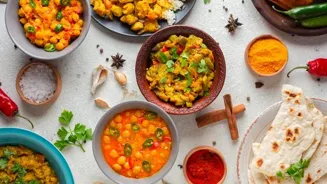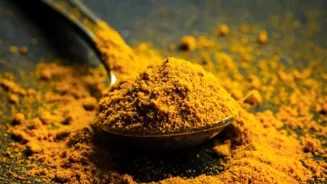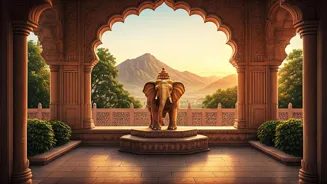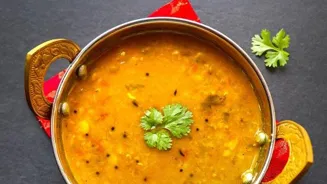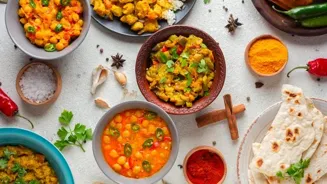Delve into the rich history of Indian desserts, from ancient traditions to modern fusions. Uncover the cultural significance in every bite!
India, a land known for its vibrant culture, diverse traditions,
and, of course, its mouth-watering food. Among the culinary treasures, Indian desserts hold a special place. They are not just sweet treats but are integral to celebrations, festivals, and everyday life.
The history of Indian desserts is as rich and varied as the country itself, with influences from ancient practices, royal kitchens, and regional specialties. Let's take a delightful journey through the sugary landscape of Indian sweets.
Ancient Indian desserts made with natural sweeteners and simple ingredients
The story of Indian desserts begins in ancient times. Imagine a time before sugar factories and fancy ingredients. Our ancestors used natural sweeteners like honey, jaggery (gur), and fruits to create simple yet satisfying sweets.
Think of the early forms of ladoos, made from grains and nuts, sweetened with honey and offered to the gods. These were not just food, but also sacred offerings. Ancient texts mention dishes like 'payasam' (kheer), a creamy rice pudding cooked in milk and sweetened with jaggery.
It's amazing to think that some of these ancient recipes are still enjoyed in Indian homes today, a testament to their timeless appeal. The use of milk products like ghee and curd was also prominent, giving these early sweets a rich and nourishing quality.
The emphasis was on using locally available ingredients and preparing sweets with simple, time-honored methods. These early sweets were more than just desserts; they were a reflection of the connection between food, nature, and spirituality.
Royal Indian kitchens: Mughal fusion desserts with opulent ingredients and techniques
The royal kitchens of India played a significant role in shaping the dessert landscape. The Mughal era, in particular, brought with it a fusion of Persian and Indian culinary traditions.
Imagine the elaborate feasts in the Mughal courts, with dishes prepared using exotic ingredients like saffron, rosewater, and dried fruits.
Sweets like 'shahi tukda' (bread pudding soaked in sweetened milk and topped with dry fruits) and 'gulab jamun' (deep-fried milk balls soaked in sugar syrup) became staples of royal banquets.
These desserts were not only delicious but also visually stunning, reflecting the opulence and grandeur of the Mughal empire. The use of nuts like almonds, pistachios, and cashews became widespread, adding richness and texture to the sweets.
The Mughal influence also brought about the introduction of new cooking techniques, such as slow cooking and baking. The royal cooks were known for their meticulous attention to detail and their ability to create desserts that were both a feast for the eyes and a treat for the taste buds.
Explore India's diverse regional sweets with unique flavors and techniques
As you travel across India, you'll discover a fascinating array of regional specialties. Each state boasts its own unique sweets, made with local ingredients and techniques.
In the East, you have the creamy 'rasgulla' (cheese balls in syrup) and 'sandesh' (sweetened cheese fudge) from Bengal, known for their delicate flavors. Down South, you'll find the delightful 'mysore pak' (gram flour fudge) from Karnataka and 'payasam' (kheer) in its many regional variations.
In the West, 'modak' (sweet dumplings) from Maharashtra and 'ghevar' (disc-shaped sweet cake) from Rajasthan are festival favorites. And in the North, 'jalebi' (crispy fried spirals in syrup) and 'ladoo' reign supreme.
Each region's unique climate, agricultural produce, and cultural practices have influenced the creation of these distinct sweets. The use of spices like cardamom, cloves, and cinnamon varies from region to region, adding unique flavor profiles.
The regional variations of payasam alone are a testament to the diversity of Indian sweets, with each state offering its own unique take on this classic dessert.
Indian sweets integral to festivals, celebrations, symbolize love, joy, tradition
Indian sweets are deeply intertwined with festivals and celebrations. No Diwali is complete without a platter of assorted sweets, including ladoos, barfi, and jalebi. During Holi, 'gujiya' (sweet dumplings filled with dried fruits) is a must-have.
Ganesh Chaturthi sees the preparation of 'modak,' Lord Ganesha's favorite sweet. Eid is celebrated with 'sheer khurma' (vermicelli pudding). Sweets are not just eaten during festivals; they are an integral part of the celebrations. Sharing sweets is a way of expressing love, joy, and goodwill.
Gifting sweets to friends and family is a common practice during festivals, strengthening bonds and spreading happiness. Many festivals have specific sweets associated with them, highlighting the cultural significance of these desserts.
The preparation of sweets for festivals often involves the entire family, creating a sense of togetherness and tradition. These sweet traditions are passed down from generation to generation, preserving the cultural heritage of India.
Modern Indian desserts blend tradition with innovation, appealing globally
Modern times have brought new twists to traditional Indian desserts. You now see fusion desserts that blend Indian flavors with Western techniques. Think of gulab jamun cheesecake or rasmalai tres leches.
Chefs are experimenting with new ingredients and presentations, creating innovative desserts that appeal to a global palate. At the same time, there is a growing appreciation for traditional sweets.
People are rediscovering the flavors of their childhood and seeking out authentic, home-style sweets. Many home bakers and small businesses are specializing in traditional Indian sweets, using time-honored recipes and high-quality ingredients.
This trend is helping to preserve the rich heritage of Indian desserts and ensure that they continue to be enjoyed for generations to come. The health-conscious are also seeking out healthier alternatives, with options that use less sugar or incorporate natural sweeteners.
The future of Indian desserts: traditional love meets modern innovation
The future of Indian desserts looks bright. While modern twists and fusion creations continue to evolve, the love for traditional sweets remains strong. There is a growing awareness of the cultural significance of Indian desserts and a desire to preserve these culinary treasures.
The use of technology is also playing a role, with online platforms making it easier to discover and order a wide variety of Indian sweets from across the country. Chefs and food enthusiasts are constantly innovating, creating new and exciting ways to experience the flavors of India.
Whether it's a classic ladoo or a modern fusion dessert, Indian sweets will continue to delight and inspire, reflecting the rich and diverse culinary heritage of India.
The journey of Indian desserts is a testament to the power of food to connect people, preserve traditions, and create moments of joy.
The History of Indian Desserts
From Traditional Sweets to Modern Twists
Indian desserts: a rich part of culture and celebrations
India, a land known for its vibrant culture, diverse traditions, and, of course, its mouth-watering food. Among the culinary treasures, Indian desserts hold a special place. They are not just sweet treats but are integral to celebrations, festivals, and everyday life.
The history of Indian desserts is as rich and varied as the country itself, with influences from ancient practices, royal kitchens, and regional specialties. Let's take a delightful journey through the sugary landscape of Indian sweets.
Indian desserts: ancient recipes with natural sweeteners
The story of Indian desserts begins in ancient times. Imagine a time before sugar factories and fancy ingredients. Our ancestors used natural sweeteners like honey, jaggery (gur), and fruits to create simple yet satisfying sweets.
Think of the early forms of ladoos, made from grains and nuts, sweetened with honey and offered to the gods. Ancient texts mention dishes like 'payasam' (kheer), a creamy rice pudding cooked in milk and sweetened with jaggery.
Royal Indian kitchens shaped dessert landscape with Mughal fusion
The royal kitchens of India played a significant role in shaping the dessert landscape. The Mughal era, in particular, brought with it a fusion of Persian and Indian culinary traditions.
Imagine the elaborate feasts in the Mughal courts, with dishes prepared using exotic ingredients like saffron, rosewater, and dried fruits.
Sweets like 'shahi tukda' (bread pudding soaked in sweetened milk and topped with dry fruits) and 'gulab jamun' (deep-fried milk balls soaked in sugar syrup) became staples of royal banquets.
Regional sweets across India showcase diverse flavors
As you travel across India, you'll discover a fascinating array of regional specialties. Each state boasts its own unique sweets, made with local ingredients and techniques.
In the East, you have the creamy 'rasgulla' (cheese balls in syrup) and 'sandesh' (sweetened cheese fudge) from Bengal, known for their delicate flavors. Down South, you'll find the delightful 'mysore pak' (gram flour fudge) from Karnataka and 'payasam' (kheer) in its many regional variations.
Indian festivals and sweets: Diwali, Holi, Ganesh Chaturthi favorites
Indian sweets are deeply intertwined with festivals and celebrations. No Diwali is complete without a platter of assorted sweets, including ladoos, barfi, and jalebi. During Holi, 'gujiya' (sweet dumplings filled with dried fruits) is a must-have.
Ganesh Chaturthi sees the preparation of 'modak,' Lord Ganesha's favorite sweet.
Indian desserts blend with Western techniques in modern fusion creations
Modern times have brought new twists to traditional Indian desserts. You now see fusion desserts that blend Indian flavors with Western techniques. Think of gulab jamun cheesecake or rasmalai tres leches.
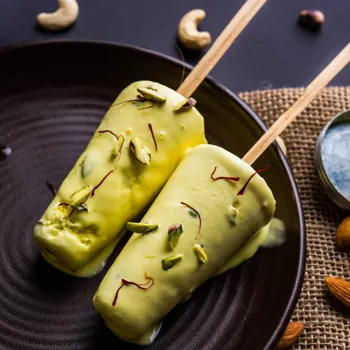
Chefs are experimenting with new ingredients and presentations, creating innovative desserts that appeal to a global palate.
Indian dessert evolution bridges tradition and modernity
The future of Indian desserts looks bright. While modern twists and fusion creations continue to evolve, the love for traditional sweets remains strong. There is a growing awareness of the cultural significance of Indian desserts and a desire to preserve these culinary treasures.
The journey of Indian desserts is a testament to the power of food to connect people, preserve traditions, and create moments of joy.
AI Generated Content. Glance/InMobi shall have no liability for the content

